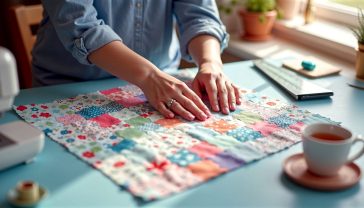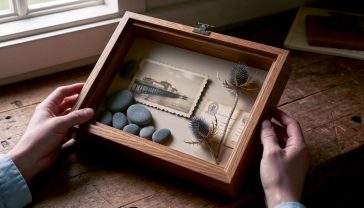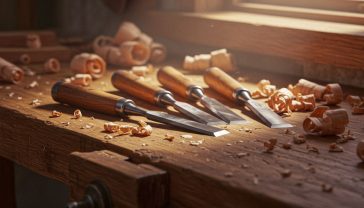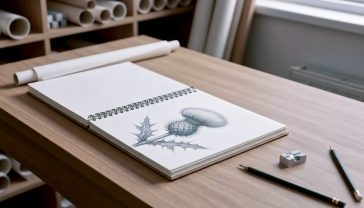The Crown Jewels of Craftsmanship: Inside Britain’s Royal Artisans
Go behind the scenes with the master craftspeople who hold a Royal Warrant. This definitive guide explores the history, skill, and secrets of Britain’s royal artisans.

This post may contain affiliate links. If you make a purchase through these links, we may earn a commission at no additional cost to you.
When you watch the grand theatre of a royal occasion—a coronation, a Trooping the Colour, a state banquet—it’s easy to get lost in the spectacle. The flash of jewels, the flawless cut of a military uniform, the gleaming curve of a horse-drawn carriage. It all seems to appear as if by magic, a perfect performance of pomp and circumstance.
But it isn’t magic.
It’s craftsmanship. Behind every single detail, from the King’s handmade shoes to the jam served at breakfast, is a person. A master artisan, a dedicated company, a quiet expert who has spent a lifetime perfecting their skill. These are the Royal Warrant holders, the chosen few entrusted to serve the Royal Household. They are the true, hidden Crown Jewels of Britain—a living library of skills passed down through generations.
This isn’t just about posh shops and fancy labels. It’s a story about pride, perfection, and a uniquely British commitment to doing things properly. It’s a world where a glovemaker can become a national treasure and a tailor’s stitch can hold a piece of history. So, let’s pull back the velvet curtain and step inside the workshops of Britain’s royal artisans. It’s a journey that reveals not just how the monarchy works, but what it means to be the very best at what you do.
What on Earth is a Royal Warrant? The Ultimate Seal of Approval
You’ve probably seen it without even realising. A grand coat of arms, featuring a lion and a unicorn, sitting proudly on a jar of marmalade or above a shop door in London. That is a Royal Warrant, and it’s one of the most respected marks of quality in the world.
A Simple Explanation: The Royal Thumbs-Up
Think of a Royal Warrant as the ultimate product review, but instead of a blogger, the reviewer is the King himself. It’s a special seal of approval given to tradespeople and companies who regularly supply goods or services to the Royal Household. It’s not a prize for being the ‘best’ in a competition; it’s a mark of trust earned over years of reliable service.
In simple terms, if a company has a Royal Warrant, it means they’ve been consistently good enough for the King for at least five years.
The Nitty-Gritty: How It Actually Works
To get a warrant, a business must have a solid trading relationship with the Royal Household. This means supplying goods or services on a normal commercial basis—no freebies allowed. The Royal Household pays for its goods just like anyone else.
After a company has been a trusted supplier for at least five of the last seven years, they can be considered for a warrant. The decision is made by the monarch on the advice of the Royal Household Warrants Committee. It’s a rigorous process. The committee looks at everything, from the quality of the product to the company’s environmental and sustainability policies. King Charles III is famously passionate about the environment, so today’s warrant holders have to prove they’re doing their bit for the planet.
A warrant lasts for up to five years and can be renewed. But it can also be taken away at any time if the quality of service drops. It’s a constant standard that needs to be met. And, crucially, a Royal Warrant is granted to an individual at the company, known as the ‘grantee’, not the company as a whole. This reminds everyone that the relationship is built on personal trust and responsibility.
The Royal Coat of Arms: A Symbol of Service
The symbol of the warrant is the Royal Arms. A warrant holder is allowed to display it on their packaging, stationery, vehicles, and shopfronts. It proudly states, “By Appointment to His Majesty The King.”
This isn’t just a fancy logo. It’s a silent promise of quality. For centuries, it has told the world that the maker of this product is trusted by the most famous family on the planet.
A History Written in Warrants: From Medieval Guilds to Global Brands
The idea of giving royal favour to the best craftsmen isn’t new. It’s a tradition that stretches back hundreds of years, and its story mirrors the history of Britain itself.
The First Royal Seal of Quality
The tradition began in the Middle Ages. In 1155, King Henry II granted a Royal Charter to the Weavers’ Company. This gave them a sort of monopoly on their trade in London, but it also meant they were recognised as the best. This was the earliest form of royal endorsement, a way for the monarch to ensure the court got the finest goods available. These early charters created the powerful trade guilds that shaped the City of London.
But the Royal Warrant as we know it today really took off under Queen Victoria in the 19th century.
Queen Victoria: The Ultimate Influencer
Queen Victoria and Prince Albert were tastemakers. They loved new technology, British industry, and high-quality goods. When they gave a company their seal of approval, the world paid attention. They issued over 2,000 Royal Warrants in their time, a huge number.
Brands that are still household names today owe their success to Victoria. Twinings was granted a warrant for tea. Cadbury’s was appointed the official chocolate and cocoa maker. Schweppes supplied their fizzy mineral waters. A warrant from Victoria turned these companies from local businesses into global brands. It was the most powerful marketing tool of the age.
In 1840, the Royal Warrant Holders Association was formed. This brought all the warrant holders together, creating a community of excellence that still exists today.
From Candlemakers to Computer Coders
The list of warrant holders over the centuries tells a fascinating story of how life has changed. In the 18th century, the list was full of sword-cutlers, wig-makers, and mole-takers (people who caught moles). As technology evolved, so did the list. Gas fitters replaced candlemakers. Car manufacturers like Daimler and Land Rover replaced horse-and-carriage builders.
Today, the list of around 800 warrant holders is a mix of the ancient and the modern. You’ll find traditional tailors and shoemakers alongside suppliers of agricultural machinery and computer software. It’s a living history, showing how the monarchy has adapted to the modern world while holding on to its ancient traditions.
Inside the Workshops: A Tour of Royal Craftsmanship
So, who are these people? Let’s step behind the quiet shopfronts and into the workshops to meet some of the masters who serve the Crown.
The Keepers of the Sparkle: Jewellers and Medallists
The Crown Jewels, housed in the Tower of London, are the ultimate symbol of the monarchy. Looking after them is a job that requires incredible skill and even more trust.
- The Crown Jeweller: This is one of the most important roles. The Crown Jeweller is responsible for the maintenance, security, and alteration of the Regalia. For over 160 years, the role was held by the house of Garrard & Co., who made many iconic royal pieces. Today, the position is held by Mark Appleby of the firm Mappin & Webb. He was the man who prepared the crowns for the coronation of King Charles III, ensuring every diamond and sapphire was perfectly in place. It’s a job where there is literally zero room for error.
- Cleave & Company: This small, discreet workshop is known for its incredible craftsmanship. They were chosen by Prince Harry to create Meghan Markle’s engagement ring. Their work is so precise and sought-after that they don’t even have a public shopfront. It’s a perfect example of a royal artisan: focused on skill, not publicity.
Dressed for the Part: Tailors, Shoemakers, and Glovers
Royal clothing isn’t just about fashion; it’s about projecting an image of stability and tradition. From military uniforms to elegant coats, every item is made to last a lifetime.
- The Savile Row Tailors: Savile Row in London is the world centre for bespoke tailoring, and its relationship with the Royal Family is historic. Firms like Gieves & Hawkes, located at No. 1 Savile Row, have been making military uniforms for over 200 years. They dress the officers of the King’s Body Guard. Every piece of gold braid is stitched by hand, every button is perfectly placed. It’s the art of making a man look like a king.
- John Lobb Ltd: A king can’t rule in uncomfortable shoes. The shoemakers at John Lobb, in St James’s, create bespoke shoes entirely by hand. The process starts with carving a wooden model of the client’s foot, called a ‘last’. This last is kept forever. The shoes are then built around it, stitched by hand, taking months to complete. A pair of Lobb shoes is designed to last a lifetime, a testament to slow, careful craftsmanship in a fast-fashion world.
- Cornelia James: For decades, Queen Elizabeth II was rarely seen without her signature gloves. They were made by Cornelia James, a firm started by a refugee from Austria in 1939. Her daughter-in-law, Genevieve, now runs the company. They still make the gloves from the finest cotton or leather, stretching and cutting each piece by hand. A simple accessory, but one that became an iconic part of the late Queen’s image, proving that even the smallest details matter.
- Kinloch Anderson: As King of Scots, Charles III often wears a kilt. Kinloch Anderson are kiltmakers and tartan specialists in Edinburgh. They hold detailed records of the clan tartans and the military tartans. Making a kilt is a mathematical art, involving pleating up to eight metres of heavy wool cloth so the pattern, or ‘sett’, repeats perfectly.
The Royal Pantry: Food and Drink Fit for a King
The Royal Warrants for food and drink offer a fascinating glimpse into the royal diet. And you might be surprised to find some of these brands in your own kitchen cupboard.
- Fortnum & Mason: The famous Piccadilly department store is practically synonymous with royalty. They have held a warrant for over 150 years. They are famous for their luxurious hampers, teas, and preserves. While we don’t know exactly what they supply to the palace, their reputation for sourcing the very best of British and international food makes them a natural choice.
- Paxton & Whitfield: Established in 1797, this is Britain’s oldest cheesemonger. Their shops are a paradise of cheese, and they are experts in British varieties like Stilton, Cheddar, and Cheshire. They provide the Royal Household with the finest cheeses, ensuring the royal cheeseboard is always perfectly ripe.
- The Royal Brews: Tea is, of course, essential. Twinings has held a Royal Warrant since 1837. For coffee lovers, H.R. Higgins of Mayfair are coffee and tea merchants with a warrant. They are a family business that roasts its coffee by hand, showing that even everyday items are chosen for their quality.
- A Touch of Bubbly: The Royal Household celebrates with the best. Several French Champagne houses, including Bollinger and Pol Roger, hold warrants. This might seem odd for the British monarchy, but the historical links and unbeatable quality have made them a long-standing tradition.
From Grand Carriages to Humble Brushes: The Everyday Artisans
A warrant isn’t just for glamorous items. It’s also for the everyday things needed to run a large household.
- Smythson of Bond Street: In a digital world, the Royal Family still understands the power of a handwritten letter. Smythson provides exquisite, personalised stationery. Their iconic blue paper and bespoke invitations are a symbol of timeless elegance.
- Kent Brushes: You probably don’t think much about your hairbrush, but G B Kent & Sons have been thinking about it since 1777. They are one of the oldest companies in Britain and hold a Royal Warrant for their handmade brushes. They use natural bristles and fine woods, turning a simple object into a work of art.
- The Car-Makers: The royals don’t just travel in carriages. Land Rover has supplied the family with rugged 4x4s for decades, perfect for driving around their country estates. For more formal occasions, Bentley and Rolls-Royce have a long history of providing state limousines. And, of course, Aston Martin is famously associated with the royals, particularly the classic DB6 driven by the Prince of Wales.
The Soul of the Craft: A Lifetime of Dedication
What unites all these different people and companies? It’s a deep, almost obsessive dedication to their craft. These skills can’t be learned overnight from a YouTube video. They are the result of years, sometimes decades, of practice.
The Path of the Apprentice
In many of these workshops, the ancient tradition of apprenticeship is still alive and well. A young person will learn their trade by working alongside a master craftsman for years. They start with simple tasks, slowly building their skills until they are ready to take on more complex work.
A tailor at Gieves & Hawkes might spend five years just learning how to sew before they are allowed to cut the cloth for a jacket. This slow, patient transfer of knowledge is how these precious skills are kept alive. It’s a system built on respect for tradition and a commitment to the future.
The Quest for the Perfect Materials
You can’t create a masterpiece with poor ingredients. Royal Warrant holders are famous for sourcing the very best materials. The tailors use the finest British wool and Scottish tweed. The shoemakers use leather from traditional tanneries. The salmon smokers at H. Forman & Son use only Scottish salmon and pure rock salt.
This focus on quality often goes hand-in-hand with sustainability, a cause close to King Charles’s heart. Many warrant holders champion local sourcing, traditional farming methods, and environmentally friendly practices. They understand that true luxury is about quality and responsibility, not just a fancy label.
The Pressure of Perfection
What’s it like to know your work will be seen and used by the monarch? It comes with a unique pressure. Every stitch, every cut, every detail must be perfect. Discretion is also essential. Royal Warrant holders are famously tight-lipped about their most famous clients. They don’t gossip or share secrets.
This relationship is built on trust. The artisans take immense pride in their work, not for the fame, but for the satisfaction of knowing they have met the highest possible standard.
A New Era: Craftsmanship Under King Charles III
The accession of a new monarch brings change. When Queen Elizabeth II passed away, all Royal Warrants granted by her became void. Companies that hold them are allowed a grace period to change their packaging, but they must reapply to the new King to continue the relationship.
This is a moment of renewal. King Charles III has long been a champion of craftsmanship, heritage, and the environment. His values will undoubtedly shape the list of warrant holders for the 21st century.
We can expect to see an even greater emphasis on sustainability. Companies that use organic materials, reduce their carbon footprint, and operate ethically will be favoured. The King’s own brand, Duchy Originals, which he started to champion organic food, has long held a warrant from his mother.
The “Charles Effect” will likely shine a light on smaller, traditional craftspeople who preserve rare skills. His passion is not for fleeting trends, but for timeless quality. The Royal Warrant under his reign will continue to be a symbol of the very best of British—a blend of heritage, innovation, and a deep respect for our planet.
A Legacy That Lives On
The world of Britain’s royal artisans is a quiet one. It’s a world of patient work, deep knowledge, and immense pride. It’s a reminder that in our throwaway culture, some things are still made to last.
The Royal Warrant is more than just a fancy logo on a biscuit tin. It’s a golden thread that connects our modern monarchy to its medieval roots. It’s a guarantee of quality that is respected around the world. And most importantly, it’s a tribute to the thousands of skilled craftspeople who, often without any public recognition, uphold a standard of excellence.
So the next time you see a royal parade, look closer. Look beyond the gold and the glitter. See the perfect stitch on a uniform, the deep shine on a leather shoe, the flawless curve of a carriage. In those details, you’ll find the real story: a living legacy of craftsmanship, proudly stamped “By Royal Appointment.”
Further Reading
For those wishing to explore this fascinating world further, these resources offer a wealth of information:
- The Royal Warrant Holders Association: The official body for all warrant holders, with a directory and history. https://www.royalwarrant.org
- The Royal Collection Trust: Explore the incredible objects, from jewellery to furniture, made by artisans for the Royal Family over the centuries. https://www.rct.uk
- Historic Royal Palaces: Learn more about the home of the Crown Jewels at the Tower of London. https://www.hrp.org.uk
- Individual Warrant Holder Websites: Many of the companies mentioned, such as Fortnum & Mason, Gieves & Hawkes, and John Lobb, have detailed histories on their own websites.






